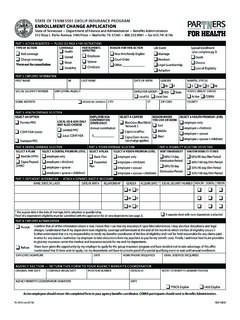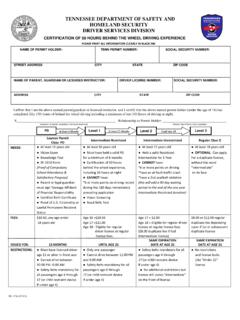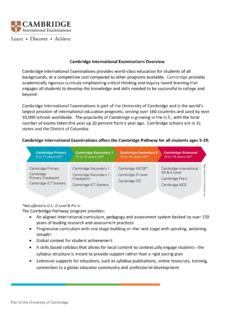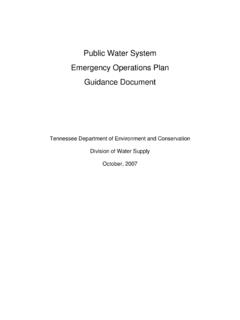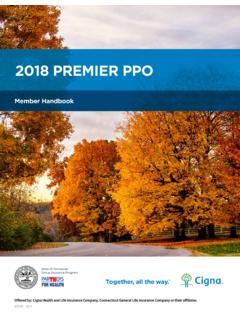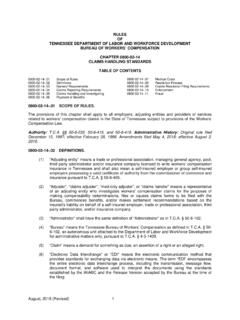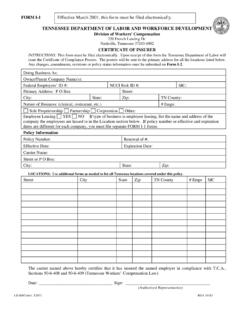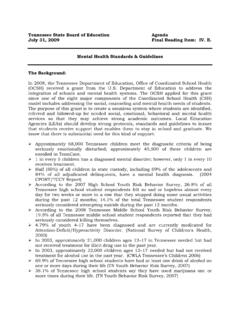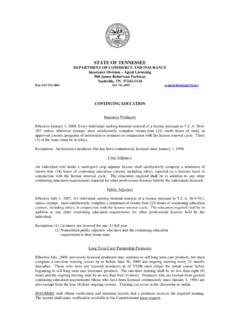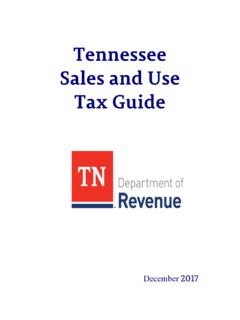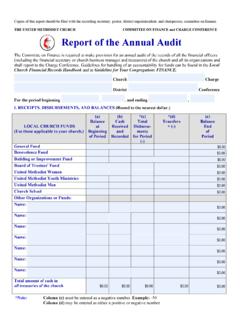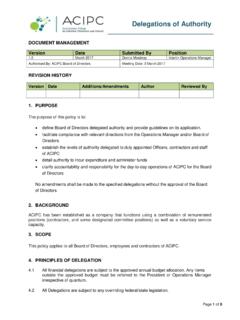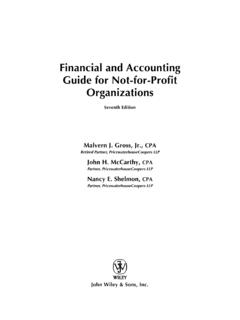Transcription of How to Conduct a Performance Audit - TN.gov
1 Performance Audit Guide How to Conduct a Performance Audit Tennessee Department of Transportation | Version | Effective 5/1/2016 Suite 1800, James K. Polk Building, 505 Deaderick St. Nashville, TN 37243 Phone: Fax: Sensitivity, Centrality, and Materiality TDOT Office of Internal Audit 2 TABLE OF CONTENTS 1 INTRODUCTION .. 3 What is Performance Auditing? .. 3 2 STANDARDS .. 4 Authoritative Standard .. 4 Supplementary Standards .. 4 3 FOREWORD AND OVERVIEW .. 5 4 GETTING STARTED PLANNING .. 7 Receive the Audit Assignment .. 7 Gathering Information about the Subject Matter .. 8 Determine the Criteria .. 9 Risk Assessment and Internal Control Reviews .. 10 Refine and Define the Audit Objectives .. 11 Select Testing Methodologies .. 12 Completing the Planning Phase .. 12 5 Audit FIELDWORK .. 14 Specific Audit Program/Plan.
2 14 Documentation .. 15 Observation(s) .. 16 Elements of an Observation .. 16 Recommendation(s) .. 17 Audit Exit Conference .. 17 6 REPORTING .. 19 Discussion Draft Report .. 19 Final 19 7 Audit FOLLOW-UP .. 20 8 LOGICAL SEQUENCE .. 21 9 IF ALL ELSE FAILS .. 22 Sensitivity, Centrality, and Materiality TDOT Office of Internal Audit 3 1 INTRODUCTION This How to Conduct a Performance Audit Guide is designed to help the TDOT s Government Accountability Professionals (GAP) understand the process for conducting Performance Audit engagements. For specific guidance on quality standards, project management, and specific Audit guidance auditors must refer to the TDOT Internal Audit Policies, Procedures, and Audit Guide . What is Performance Auditing? Government Performance auditing is an offshoot of operational auditing that focuses on improving how governments provide programs and services.
3 According to Government Auditing Standards (GAS), " Performance audits are defined as audits that provide findings or conclusions based on an evaluation of sufficient, appropriate evidence against criteria (GAS, ). Performance auditing is slightly more complex than a pure financial and a pure compliance Audit engagement. Because it encompasses the operations, Performance audits tend to take a broader look at a division, an operation, a process, or even a transaction. Performance audits provide objective analysis to assist management in improving operational Performance , reducing costs, and facilitating informed decision-making. Performance Audit objectives can vary, but the goal is to assess program effectiveness, economy, and efficiency; ensuring the presence of internal controls; compliance with laws, policies, and regulations; and prospective analyses.
4 Performance audits may have more than one overall objective (GAS ) Sensitivity, Centrality, and Materiality TDOT Office of Internal Audit 4 2 STANDARDS To guide auditors in performing the work, we follow guidance provided by standard-setting bodies such as the Government Accountability Office (GAO), the American Institute of Certified Public Accountants (AICPA), and others. These professional standards do not necessarily dictate how we Conduct the Audit ; but they do set quality expectations, for which to judge our Performance of the Audit engagement. Standards are principle-focused and provide a framework for performing high-quality Audit work. Three distinct demarcations govern a Performance Audit engagement, the (a) planning phase, (b) fieldwork, and the (c) reporting phase.
5 We mark the end of each phase by a tangible work product, namely, (a) the planning memorandum, (b) observation sheets, and (c) the draft and final reports respectively. Authoritative Standard The Office of the Internal Audit adheres to Government Auditing Standards (GAS), sometimes referred to as the Yellow Book or GAGAS, as promulgated by the Comptroller General of the United States Government Accountability Office, Washington, We Conduct Audit and attestation engagements in accordance with all applicable GAS standards. For all Audit and attest work undertaken by IA, auditors shall follow all applicable GAGAS requirements and cite the extent of compliance with those requirements in the Audit report. We will Conduct Non- Audit projects in accordance with appropriate standards, based on the needs of the engagement.
6 When conducting nonaudit engagements, our reports will not reference compliance to GAGAS. Supplementary Standards The Yellow Book allows the IA to use other professional standards issued by other authoritative bodies in conjunction with GAGAS such as: The AICPA for financial audits and attestations (GAS a). The IIA for Performance audits (GAS a). The ISACA for information technology engagements (GAS e). Supplementary standards will be utilized whenever the Performance Audit engagement necessitated its use. A Modified or Unmodified GAGAS compliance statement will be included in the final report as applicable (GAS ). Sensitivity, Centrality, and Materiality TDOT Office of Internal Audit 5 3 FOREWORD and OVERVIEW Auditing is auditing is auditing This section of the manual provides a big picture view of the entire Audit process.
7 This manual is designed to allow the auditor to gain confidence to take on any Audit assignment. An Audit is an Audit is an Audit and they all work the same way; no matter where you are and what industry you are in. All audits go through the same basic steps. However, depending on the engagement, the sequential order may differ. What differs between types of audits? Audit engagements differ only in three elements: Subject Matter what you will be auditing Criteria what you will be using to evaluate the subject matter against Standards What standards are applicable to the engagement (AICPA, GAGAS, or IPPF) Example of Differences FINANCIAL COMPLIANCE Performance / OPERATIONAL SUBJECT MATTER Financial Statements Grants ???? CRITERIA GAAP Grant Requirements ???? STANDARD(S) AICPA or GAGAS AICPA, GAGAS, or IPPF GAGAS or IPPF Auditing is NOT linear It is true that for all audits, the plans, objectives, and procedures may change because auditing is a dynamic process.
8 However, for the purpose of teaching the Audit process, auditing has to be shown as a linear activity divided into phases. For Sensitivity, Centrality, and Materiality TDOT Office of Internal Audit 6 example, in the stepwise illustration of the Audit process below, observations or findings are listed at or near the end but in reality observations can appear at any point of the process. It is the job of the auditor to obtain sufficient evidence to substantiate the observations. Therefore, observations are developed as the Audit progresses. Which of the auditing standards dictate the order of Audit activities? Unbelievable but true, GAGAS and the IPPF do not provide guidance on the ordered steps to Conduct an Audit . The only standard-setting body that does this is the AICPA, and their guidance is in the form of a conceptual framework.
9 The conceptual framework is actually a risk assessment process and is decision-making model; it is comprised of: 1. Gaining an understanding of the subject 2. Assessing risks 3. Responding For specific language on the standards, see AICPA AU-C 315 Understanding the Entity and Its Environment and Assessing the Risks of Material Misstatement . Audit Planning Steps: Sensitivity, Centrality, and Materiality TDOT Office of Internal Audit 7 4 GETTING STARTED PLANNING Receive the Audit Assignment Once the auditor receives the Audit assignment, the planning phase is underway. Planning is the most critical part of an Audit engagement. A well thought out and planned engagement is the key to Audit efficiency. Planning begins with acquiring a knowledge of the audited entity and their essential operations; delineating the scope of work; setting broad objectives that will be specifically defined at the conclusion of the Audit survey; assessing inherent risks and their corresponding controls (and the resulting residual risks); developing the testing approach or methodology to meet the Audit objectives; allocation of Audit resources; and the anticipation of problems and making required adjustments.
10 The overall objectives of the Audit planning phase are (1) to gain an understanding of the auditee, (2) understand the organization s control environment, and (3) to prepare a functional and effective work program that will be utilized during fieldwork. All members of the Audit team must understand the auditee, the Audit scope, and their role in the Audit . Set Broad Audit Objectives Broad objectives are generated several ways. Usually, the broad objectives are determined by the results of enterprise-wide risk assessments, persistent Audit issues in one area, management requests, or emerging issues. Audit management initiates the broad Audit as delineated within the annual Audit plan. The Audit manager and the in-charge auditor discuss these broad objectives to the auditee at the entrance conference.
